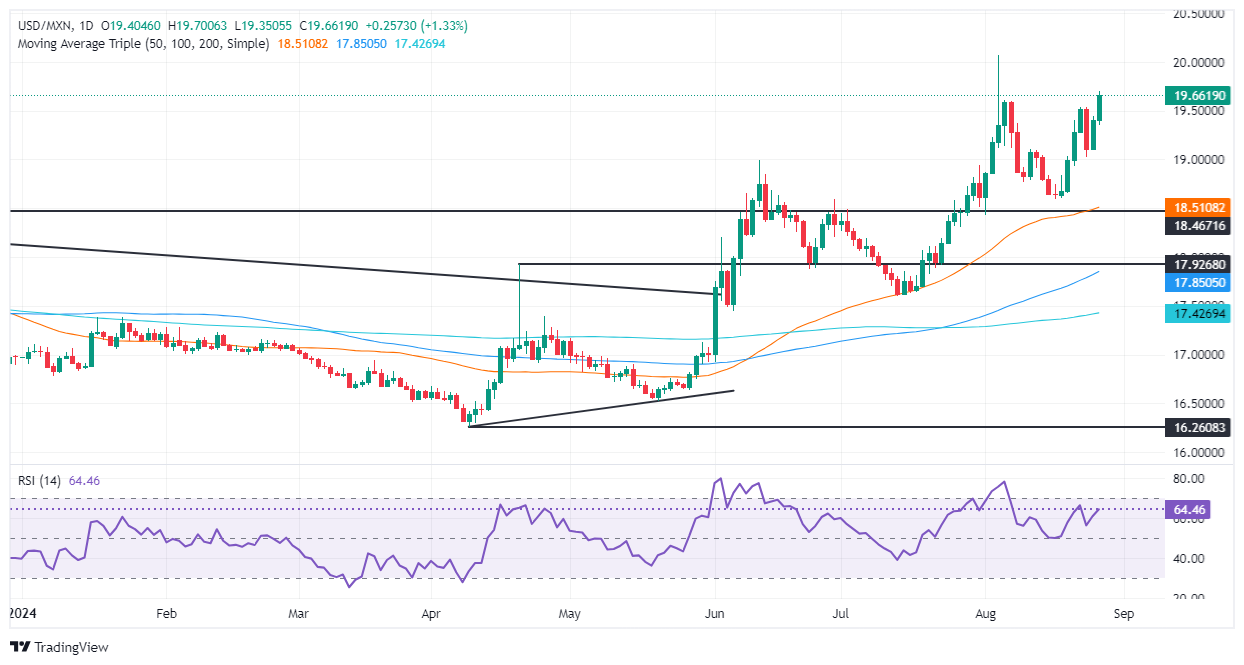Mexican Peso tumbles amid heightened political uncertainty

- Mexican Peso plunges as fears of judicial reforms by Congress spark foreign investor sell-off.
- Political tension escalates after President Lopez Obrador halts ties with US Embassy over reform critiques.
- Trade data overlooked; smaller-than-expected trade deficit eclipsed by political focus.
The Mexican Peso tumbled sharply, sparked by foreign investors’ fears that the upcoming Mexican Congress could approve the judiciary reform. Nevertheless, a commission of deputies approved the ruling on the reform, which is expected to be voted on once the new Congress takes office on September 1. This sparked fears among investors, which ditched the Mexican Peso as the USD/MXN trades at 19.75, posting gains of over 1.70%.
Mexico’s economic docket revealed that the Balance of Trade printed a deficit of $-0.072 billion, less than the $-1.35 billion expected by most analysts. However, analysts ignored this, remaining eyed on Mexico’s political developments.
The USD/MXN rose sharply after newswires revealed that Mexico’s President Andres Manuel Lopez Obrador said there is a “pause” in their relationship with the US Embassy after the Ambassador commented on proposed judicial reform.
On August 22, US Ambassador Ken Salazar said, “Based on my lifelong experience supporting the rule of law, I believe that the direct election of judges represents a major risk to the functioning of Mexico’s democracy. Any judicial reform must have safeguards that guarantee that the judiciary is strengthened and not subject to the corruption of politics.”
The Canadian Ambassador to Mexico, Graeme C. Clark, echoed some of his comments during the Mexico-Canada business forum. Clark commented that the reform has raised doubts about the stability of the legal framework in Mexico, which is essential to maintaining the confidence of foreign investors.
Across the border, the US economic docket featured the Conference Board (CB) Consumer Confidence for August, which was expected to deteriorate from 101.9 in July to 100.7, according to analysts. Nevertheless, consumers grew more optimistic about the US economy, with the index rising to 103.3.
This boosted the Greenback against most emerging market FX currencies, even though Federal Reserve (Fed) Chair Jerome Powell gave the green light last week to begin reducing interest rates. This hurt the Greenback’s prospects against most G7 FX currencies, but the US Dollar continues gathering steam over the Mexican Peso.
Daily digest market movers: Mexican Peso depreciates also on geopolitical risks
- Another driver that pressures the Peso was the escalation of the Israel-Hezbollah conflict in the Middle East.
- Traders will eye Fed speakers, the release of US Q2’s 2024 GDP, and the Fed’s preferred inflation gauge, the Core Personal Consumption Expenditures Price Index (PCE).
- Data from the Chicago Board of Trade (CBOT) suggests the Fed will cut at least 100 basis points (bps), according to the fed funds rate futures contract for December 2024.
Technical outlook: Mexican Peso weakens as USD/MXN hits 19.70
The USD/MXN uptrend remains in place, with buyers gaining momentum as the exotic pair reached a two-week peak of 19.70, a level last hit on August 5. The Relative Strength Index (RSI) hints that bulls are in charge, which means the pair could aim higher.
If USD/MXN clears 19.70, the next resistance would be the 20.00 figure, followed by the current year-to-date (YTD) high at 20.22. Once cleared, further gains are seen, with the 20.50 supply area up next.
Conversely, if USD/MXN tumbles below 19.50, this could expose the 19.00 figure. A breach of the latter and further losses are expected, with the following support being the August 19 low of 18.59, followed by the 50-day Simple Moving Average (SMA) at 18.48.
Mexican Peso FAQs
The Mexican Peso (MXN) is the most traded currency among its Latin American peers. Its value is broadly determined by the performance of the Mexican economy, the country’s central bank’s policy, the amount of foreign investment in the country and even the levels of remittances sent by Mexicans who live abroad, particularly in the United States. Geopolitical trends can also move MXN: for example, the process of nearshoring – or the decision by some firms to relocate manufacturing capacity and supply chains closer to their home countries – is also seen as a catalyst for the Mexican currency as the country is considered a key manufacturing hub in the American continent. Another catalyst for MXN is Oil prices as Mexico is a key exporter of the commodity.
The main objective of Mexico’s central bank, also known as Banxico, is to maintain inflation at low and stable levels (at or close to its target of 3%, the midpoint in a tolerance band of between 2% and 4%). To this end, the bank sets an appropriate level of interest rates. When inflation is too high, Banxico will attempt to tame it by raising interest rates, making it more expensive for households and businesses to borrow money, thus cooling demand and the overall economy. Higher interest rates are generally positive for the Mexican Peso (MXN) as they lead to higher yields, making the country a more attractive place for investors. On the contrary, lower interest rates tend to weaken MXN.
Macroeconomic data releases are key to assess the state of the economy and can have an impact on the Mexican Peso (MXN) valuation. A strong Mexican economy, based on high economic growth, low unemployment and high confidence is good for MXN. Not only does it attract more foreign investment but it may encourage the Bank of Mexico (Banxico) to increase interest rates, particularly if this strength comes together with elevated inflation. However, if economic data is weak, MXN is likely to depreciate.
As an emerging-market currency, the Mexican Peso (MXN) tends to strive during risk-on periods, or when investors perceive that broader market risks are low and thus are eager to engage with investments that carry a higher risk. Conversely, MXN tends to weaken at times of market turbulence or economic uncertainty as investors tend to sell higher-risk assets and flee to the more-stable safe havens.
